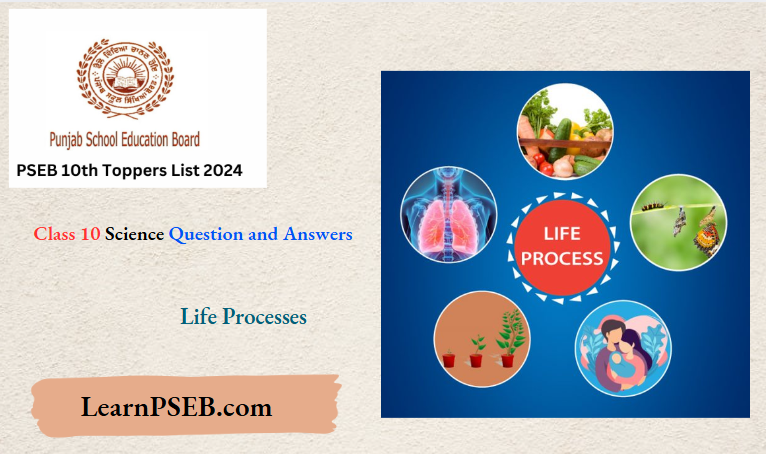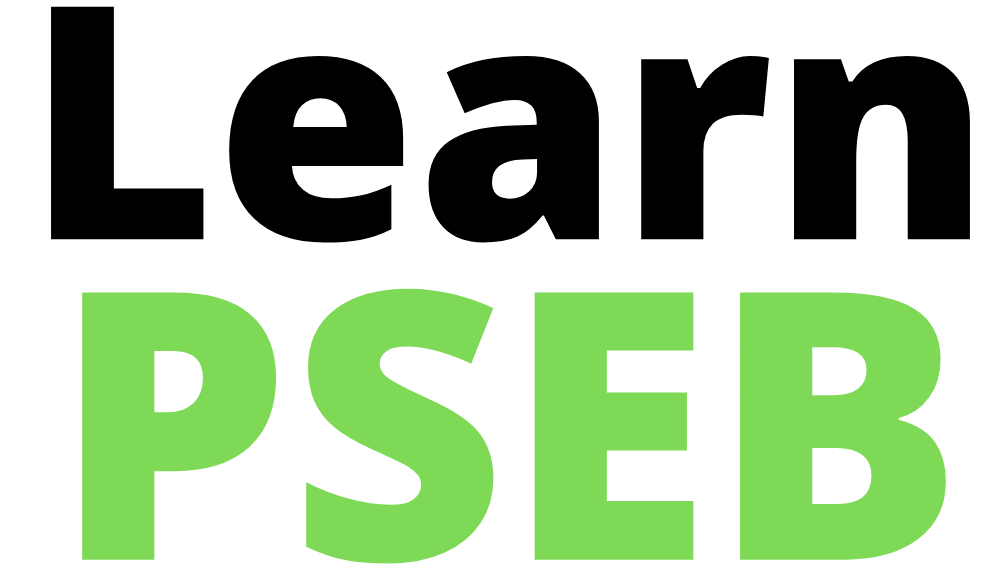Punjab State Board Class 10 Biology Chapter Life Processes Question and Answers
Question 1. What is translocation? How does it take place in plants?
Answer:
Translocation
Translocation is the transport of food and other solutes in the phloem of plants. It occurs from the region of manufacture or storage to the area of consumption in a mass flow due to the development of a turgor gradient.
Question 2. Leakage from blood vessels reduces the efficiency of the pumping system. How is leakage prevented?
Answer:
Leakage from blood vessels reduces the efficiency of the pumping system
In the area of leakage, blood platelets burst to release thromboplastin. It helps in the formation of a fibrin network in which blood cells accumulate to seal the area.
Read And Learn More 10th Class Science Solutions
Question 3. Mention the two main components of the transport system in plants. State one function of each.
Answer:
The two main components of the transport system in plants
- Plants have two components in their transport system, the xylem and phloem. Xylem transports sap (water and minerals) by means of its tracheary elements of vessels and tracheids.
- The movement is unidirectional from root to aerial parts. Phloem transports food by means of its sieve tubes both in the upward and downward directions.
Punjab State Board Life Processes Class 10 Science

Question 4. Give reason :
- Ventricles have thicker walls than the atria
- Capillaries have one-cell thick walls.
Answer:
- Atria receive blood from veins and pump the same in two adjacent ventricles. Ventricles have to pump blood forcefully in order to send it to different parts of the body.
- Capillaries are meant for the exchange of materials between tissue fluid and blood.
Question 5. How are O2 and CO2 transported in human beings?
Answer:
Both are transported through blood. Oxygen travels in a combined form with haemoglobin as oxyhaemoglobin. Carbon dioxide is transported both in plasma (77%) as well as combined with haemoglobin (23%).
Punjab State Board Life Processes Class 10 Science
Question 6.
- What is the role of fibrinogen?
- How is blood clotting useful?
Answer:
- Fibrinogen terms insoluble fibrin that polymerises and produces a network as the base of blood clots.
- It seals the place of injury in the blood vessel. As a result, blood loss from the injured blood vessel stops.
Question 7. What do you mean by double circulation? Why is it necessary?
Answer:
Double circulation
Double circulation is the passage of the same blood twice through the heart in order to complete one circulation. One step is the passage of deoxygenated blood from the right ventricle to the lungs and the return of oxygenated blood to the left auricle.
The second is the pumping of oxygenated blood to the rest of the body and the return of deoxygenated blood to the right auricle.
PSEB Class 10 Science Chapter 1 Life Processes Solutions
Importance.
- It provides for thorough oxygenation of the whole deoxygenated blood in the lungs.
- It ensures the supply of completely oxygenated blood to all body parts for their efficient working and thermoregulation.
Punjab State Board Question 8. List three kinds of blood vessels and their functions.
Answer:
Capillaries, arteries and veins.
Capillaries.
- Exchange of materials between blood and tissue fluid.
- Filtering out tissue fluid.
- Diapedesis for killing germs.
Artery,
- Supply of oxygenated blood to all body parts
- Sending deoxygenated blood to lungs for oxygenation
Veins.
- Carrying deoxygenated blood from various body parts to the heart.
- Carrying of oxygenated blood from lungs to heart.
Punjab State Board Life Processes Class 10 Science
Question 9.
- What is the composition of blood?
- How are oxygen and carbon dioxide transported in our bodies?
Answer:
- Composition of Blood. Plasma (55%) and blood cells (45%). Blood cells are of three types—erythrocytes, leucocytes and blood platelets.
- Oxygen is transported as oxyhaemoglobin (97%) and a small quantity dissolved in plasma.
- Carbon dioxide is transported as carbaminohaemoglobin (23%), bicarbonate (70%) and carbonic acid (7%) in plasma.
Life Processes Class 10 Question and Answers PSEB
Question 10. What is translocation? Why is it essential for plants? Where are the substances translocated by phloem delivered?
Answer:
Translocation
Translocation. It is the passage of food and other solutes from the region of their source to the region of their sink or utilisation.
- Requirement. Every cell requires food for its subsistence while food is available only from the region of manufacture and storage.
- Delivery. Though every cell requires food, the major areas of delivery of food materials are growing regions, growing fruits and storage regions.
Question 11. Explain why is transportation of materials is necessary in animals.
Answer:
Animals have specialised regions for digestion of food, exchange of gases and elimination of wastes.
- However, every cell of the body requires food materials and oxygen. It also produces carbon dioxide and wastes.
- Therefore, a transport system (blood circulatory system) is required to pick up nutrients from the digestive tract, oxygen from the lungs, and hormones from endocrine glands for supply to cells.
- The transport system also collects carbon dioxide and wastes to take them to the lungs and kidneys.
Question 12. Give one function each of
- Blood vessels
- Lymph and
- Heart.
Answer:
- Blood Vessels. Transport of blood from heart to body parts and back, exchange of materials between blood and tissue fluid in the region of capillaries.
- Lymph. It collects extra tissue fluid, secretions and excretions from the tissues for pouring into blood.
- Heart. It pumps oxygenated blood to different body parts and deoxygenates to the lungs.
PSEB Class 10 Biology Life Processes Notes
Question 13. Write three types of blood vessels. Give one important feature of each.
Answer:
Three types of blood vessels
The three types of blood vessels are capillaries, arteries and veins.
- Capillaries. Very fine tubes with walls made of single layers of cells. They are specialised in exchanging materials with tissue fluid.
- Arteries. They have thick elastic walls with narrow lumen. Arteries carry blood away from the heart. They usually possess oxygenated blood, except for pulmonary arteries.
- Veins. They have thin walls, and internal valves, with wide lumen carrying usually deoxygenated blood towards the heart, except pulmonary veins.
Question 14. Define the term transpiration. Design an experiment to demonstrate this process.
Answer:
Transpiration
Transpiration is the loss of water in vapour form from the aerial parts of the plants.
Experiment.
- Take a well-watered potted plant,
- Cover it shoot system with a transparent polythene sheet. Tie the edges of the sheet properly with thread.
- Place the apparatus in bright sunlight for 30-45 minutes,
- Observe the appearance of water droplets on the inner side of the polythene covering,
- Apparently, the shoot has lost water in vapour form which has condensed.
Question 15. What is transpiration? List its two functions.
Answer:
Transpiration. It is the loss of water in vapour form from the aerial parts of the plants.
Functions.
- Transpiration creates a force for absorption and ascent of water.
- It prevents overheating of plants exposed to strong sunlight.
Question 16. List two types of transport systems in human beings and write the functions of any one of them.
Answer:
Blood circulatory system and lymphatic system.
Functions of Blood Circulatory System.
- Transport of oxygen.
- Transport of carbon dioxide.
- Transport of digested food.
- Transport of waste products.
- Transport of hormones.
- Transport of salts.
- Plugging place of injury.
- Protection from pathogens.
Functions of Lymphatic System.
- Transport of digested fat from the intestine and later passage into the blood.
- It maintains blood volume by draining extra tissue fluid and passing it into the blood.
Punjab Board Class 10 Science Chapter 1 Solutions
Question 17. List four functions of the human heart. Why is double circulation necessary in the human body?
Answer:
Functions of Heart.
- Receiving deoxygenated blood from various parts of the body in the right auricle.
- Pumping the deoxygenated blood into the lungs for oxygenation.
- Receiving oxygenated blood from lungs in left auricle.
- Pumping the oxygenated blood to all parts of the body.
Double Circulation. It is the passage of the same blood twice through the heart, once for complete oxygenation and afterwards supply of pure oxygenated blood to all parts human of the body. It meets the high energy requirement of the body for thermoregulation and high activity.
Question 18. What is haemoglobin? State the consequences of deficiency of haemoglobin in our bodies.
Answer:
Haemoglobin
- Haemoglobin is a respiratory pigment of the body. It is present inside the red blood corpuscles. Haemoglobin combines with oxygen to form oxyhaemoglobin. As oxyhaemoglobin, it reaches all parts of the body.
- Oxygen separates from haemoglobin and diffuses into the tissue fluid and then into living cells where it is being consumed in respiration. Haemoglobin also carries a smaller amount of carbon dioxide from tissues to the lungs.
- Deficiency. A deficiency of haemoglobin, also called anaemia results in less supply of oxygen to tissues that produce lesser energy so that all activities of the body slow down.
